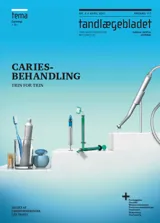Plastforsegling og infiltration af okklusale og approksimale carieslæsioner
Plastforsegling er en gængs non-invasiv behandling til standsning af superficielle okklusale carieslæsioner i det unge permanente tandsæt. Plastforsegling har også vist sig effektiv til at standse superficielle approksimale læsioner, men anvendelsen er meget begrænset i Danmark. En ny teknik, plastinfiltration, er primært introduceret til behandling af approksimal caries, og resultaterne fra de første kliniske undersøgelser viser en bedre effekt end af fluorapplikation til behandling af sådanne læsioner. Der er endnu ingen kliniske undersøgelser af plastinfiltration af okklusal caries. Resultaterne fra en ny dansk undersøgelse ‒ SEAL-DK ‒ viser, at manifeste okklusale carieslæsioner, som traditionelt behandles operativt med en fyldning, i stedet kan plastforsegles, og at det som oftest vil være muligt at stoppe carieslæsionens progression, hvis forseglingen er intakt og tæt. Formålet med denne artikel er at beskrive tidspunktet for non-invasiv og invasiv behandling af carieslæsioner samt indikationsområderne for plastforsegling/infiltration af okklusale og approksimale carieslæsioner i det primære og permanente tandsæt. Samtidig beskrives indikation og resultater fra SEAL-undersøgelsen.
Resin sealing and infiltration of occlusal and proximal caries lesions
Resin sealing is a standard non-invasive treatment to arrest superficial occlusal caries lesions in the young permanent dentition. Resin sealing has also shown to be effective in stopping progression of superficial proximal lesions, but the use of the treatment is very limited in Denmark. A new technique, resin infiltration, is introduced mainly for treatment of proximal caries, and the results of the first clinical studies show a superior efficacy in comparison to fluoride application for treatment of such lesions. There are no clinical studies of resin infiltration of occlusal caries. Results from a new Danish study ‒ SEAL-DK ‒ shows that manifest occlusal caries lesions, which are traditionally treated operatively with a filling, can instead be sealed with resin, and it will often be possible to stop progression of the caries lesion, if the sealant is intact and tight. The aim of this paper is to describe the point of non-invasive and invasive treatment of carious lesions, as well as the indication for the use of resin sealing/infiltration of occlusal and proximal carious lesions in the primary and permanent dentition. At the same time the paper describes the results and implications of the SEAL-study.


